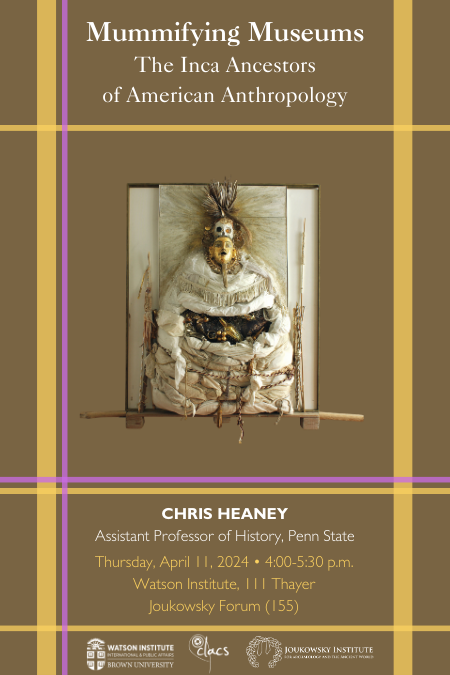
Thursday, April 11, 2024
4:00-5:30 p.m.
Joukowsky Forum (155), 111 Thayer
Light refreshments at 3:30 p.m.
Talk at 4:00 p.m.
Watch Webcast
About the Event
Between 1820 and 1920, the largest single population of human remains in American museums like the Smithsonian, the American Museum of Natural History, and Harvard's Peabody was from the Andes. By collecting these "ancient Peruvian" mummies and skulls, anthropologists sought a foundation for the historical study of race worldwide. But in doing so, they compounded a far longer struggle for the ancestral dead in the Andes—one that began when Spain invaded the empire of Tawantinsuyu in 1532 and confiscated its Inca ancestors. This longer history of the theft of Indigenous bodies makes clear the responsibility of U.S. museums to the history of supposedly more distant populations, whose racialization fueled grave-robbing throughout the Americas. But it also reveals how Peruvian intellectuals and grave-openers, some of Inca and Andean descent, used the dead to transform their study, curating these “scientific ancestors” as evidence of historical precedence, sovereignty, climactic care, healing, and national belonging. This work preceded North American efforts at decolonization by decades, if not centuries, and challenges our understanding of what it might mean to mummify a museum.
About the Speaker
Christopher Heaney is a historian of Latin America, with research interests in the history of science, indigeneity, museums, race, and deathways in the Andes, Americas, and the World. He is the author of two books. His most recent, "Empires of the Dead: Inca Mummies and the Peruvian Ancestors of American Anthropology" (Oxford University Press, 2023), is a history of the collection and display of Inca mummies and ancient Peruvian skulls in the Americas, spanning from the 16th century to the present. His prior book, "Cradle of Gold: The Story of Hiram Bingham, a Real-Life Indiana Jones and the Search for Machu Picchu" (2010), was a history of Yale University’s conflict with Peru over the excavation of Machu Picchu, and advocated for the return of the site’s human remains and gravegoods to Peru. It was published in Spanish as "Las Tumbas de Machu Picchu: La historia de Hiram Bingham y la Busqueda de las últimas ciudades de los Incas" in 2012. His third book will be a history of the colonial laws regulating grave-robbing in the Anglo-Iberian Atlantic World, and their assault upon Indigenous sovereignty.
At Penn State, he trains undergraduate and graduate students in Colonial and Modern Latin American history, the history of Peru and the Incas, the history of science, and the cultural history of United States-Latin American relations. His approach to teaching presumes a Latin America that has always been modern, and an Americas and Atlantic World shaped by movements, infrastructures, and knowledges of Native peoples. In 2012, he co-founded and was the Editor-in-Chief of The Appendix, a journal of narrative and experimental history. From 2016 to 2018 he was the Barra Postdoctoral Fellow at the McNeil Center for Early American Studies, at the University of Pennsylvania in Philadelphia. His writing has been featured by The New Yorker, The Atlantic, and The New York Times.


